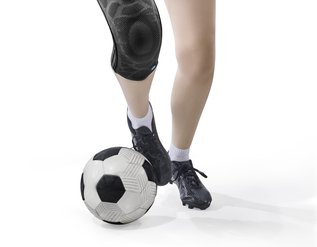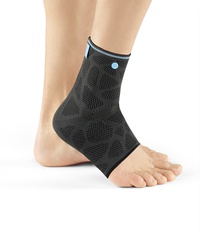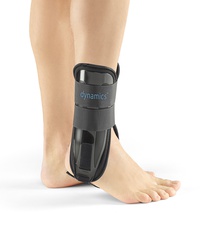Ankle Pain
The ankle is the most heavily strained joint
As the ankle joint has to endure an enormous amount of pressure every day since our ankles carry most of our body weight, it is the most heavily strained joint in the human body. Depending on the type of movement, this can cause major strain on the ankle. Therefore, awareness of stability and load-bearing capacity is essential to prevent pain.
The ankle joint connects the foot to the lower leg. As such, it needs to be very flexible and agile. It is further strengthened by the surrounding ligaments and tendons. Strictly speaking, the ankle consists of two joints: the upper and lower ankle joint (UAJ and LAJ). The UAJ is responsible for enabling the foot to stretch and bend while the LAJ enables lateral movements of the foot. Due to high stress in these areas, they are extremely prone to pain and injuries caused by accidents while playing sports and even while going about your everyday life.
What is the ankle joint made up of?
The ankle joint is made up of a joint cavity and condyle, which fit together like two jigsaw pieces. These two parts are covered with cartilage. The cavity between them is filled with synovial fluid. This prevents friction between the two surfaces. Should an abrasion occur, it can lead to unpleasant arthrosis. Excessive stress on the joint can lead to an aggravation of symptoms and, inevitably, to Ankle Pain.
Causes and consequences of Arthrosis
Additional cushioning in the form of bursa filled with synovial fluid can be found on joints that are subjected to heavy loads, such as the knees or elbows. These cushions are necessary as the force exerted on the joint can be as heavy as our own body weight many times over, depending on the movement.
You can find out more about the human joint here

Common ankle injuries
While you are taking a walk, doing some cleaning at home, or while doing your favourite exercises, you can sometimes accidentally twist your ankle sideways. The consequence of this can be a sprain or strain. The pain is usually accompanied by swelling and the area can become sensitive to pressure.
Depending on the severity of the twisted ankle, the ligament can be stretched and, in the worst case, it can even lead to a torn ligament. As our ligaments connect individual bones, they must be inherently elastic and stable. Nevertheless, ligaments cannot endure unlimited amounts of stress. The lateral ligaments can get overstretched or even tear if you twist your ankle. This can lead to water retention and bruising (haematomas), which can cause swelling of the foot. This, in turn, can cause the ankle to hurt and make walking and running a very painful ordeal.

How is Ankle Pain treated?
The RICE rule is applied to treat ankle pain:
- R stands for REST: When a muscle is acutely strained, you should take a break and rest. Under no circumstance should you continue exercising while you are experiencing pain.
- I stands for ICE: The aching ankle joint should be treated immediately with cold water, ice, or cooling packs to prevent bruising and swelling, which can cause additional pain. You should take care not to place the ice directly on the skin, however.
- C stands for COMPRESSION: You can also prevent larger bruising and further swelling by using elastic dressings or bandages. However, the compression must not pinch off the muscle.
- E stands for ELEVATION: In addition to cooling and compression, elevating the affected limbs also helps prevent stronger bleeding (blood congestion) or swelling after the strain.
Criticisms of the RICE method
In cases of acute injuries such as torn ligaments or fractures, oedema (swellings) can develop (depending on the severity of the injury). Liquid then accumulates in the affected region of the body. Once this has happened, it cannot be treated with external ice treatment. Therefore, cooling with ice is not recommended, according to the latest findings, as it is usually already too late for this kind of treatment.
Further options for treatment of Ankle Pain
After a rupture, strain, or sprain of the ankle, bandages can provide the necessary security. The Dynamics Plus Ankle Support Bandage is ideal for when your ankle is causing you pain. The design reduces the development of folds around your foot, thus increasing comfort. The bandage also clings gently to the skin. Massaging silicone pads help to rapidly reduce oedema. The breathable, latex-free microfibre fabric keeps the affected area at a pleasant temperature. Additionally, the Dynamics Plus Ankle Bandage can provide relief when treating arthrosis or recurrent tendonitis.




